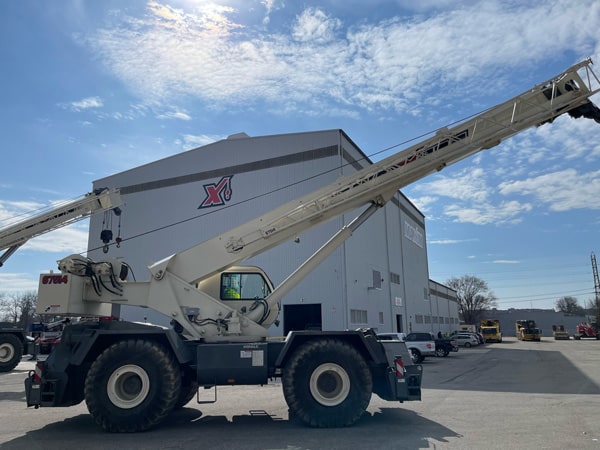When faced with the demanding challenges of construction and industrial work in rugged, off-road environments, rough terrain cranes stand out as the heavy-duty champions of maneuverability and stability. These specialized cranes are engineered with unique features such as oversized tires, all-wheel drive, and advanced steering modes to tackle the toughest of terrains with ease.
In this blog post, we’ll explore the intricacies of rough terrain cranes, revealing how their design, capabilities, and ongoing technological advancements make them indispensable for a variety of applications.
From their robust structure to the diverse applications they serve, rough terrain cranes are the unsung heroes of off-road lifting tasks. As we delve into the world of these powerful machines, you’ll gain insight into what makes them a preferred choice for industry professionals in construction, maintenance, and more.
Overview of Rough Terrain Cranes
Rough terrain cranes are specialized lifting devices characterized by their robust structure and agility, designed to navigate challenging off-road environments. In addition to their main boom, rough terrain cranes also feature a jib, providing added versatility for reaching heights and distances beyond the capabilities of the main boom alone.
These cranes are defined by OSHA as equipped with a boom and designed to be transportable over the road. Their single cab configuration serves the dual purpose of driving and crane operation, streamlining the process and minimizing the space required for control. Their compact size and powerful capabilities make them ideal for projects where space is limited and challenging terrain is a factor.
Rough terrain cranes boast impressive lifting capacities, often ranging from 30 to 165 tons, making them suitable for a wide range of heavy lifting tasks. Additionally, their boom lengths typically range from 30 to 205 feet, providing versatility in reaching various heights and distances.
In addition to their robust lifting capabilities, rough terrain cranes are renowned for their agility and speed on job sites. With all-wheel drive capabilities and advanced steering modes, they can swiftly navigate through challenging terrain, outperforming other cranes in terms of mobility and efficiency.
Moreover, these cranes are equipped with enhanced features such as stability control systems and advanced load monitoring technology, to aid in safe and precise lifting operations in rugged environments.
From construction and industrial applications to oil and gas projects, rough terrain cranes provide a versatile and efficient solution for handling heavy loads in challenging terrain. Their faster mobility and impressive lifting capacity make them indispensable for completing projects with speed and precision, ultimately maximizing efficiency and reducing downtime.
Design Characteristics and Capabilities
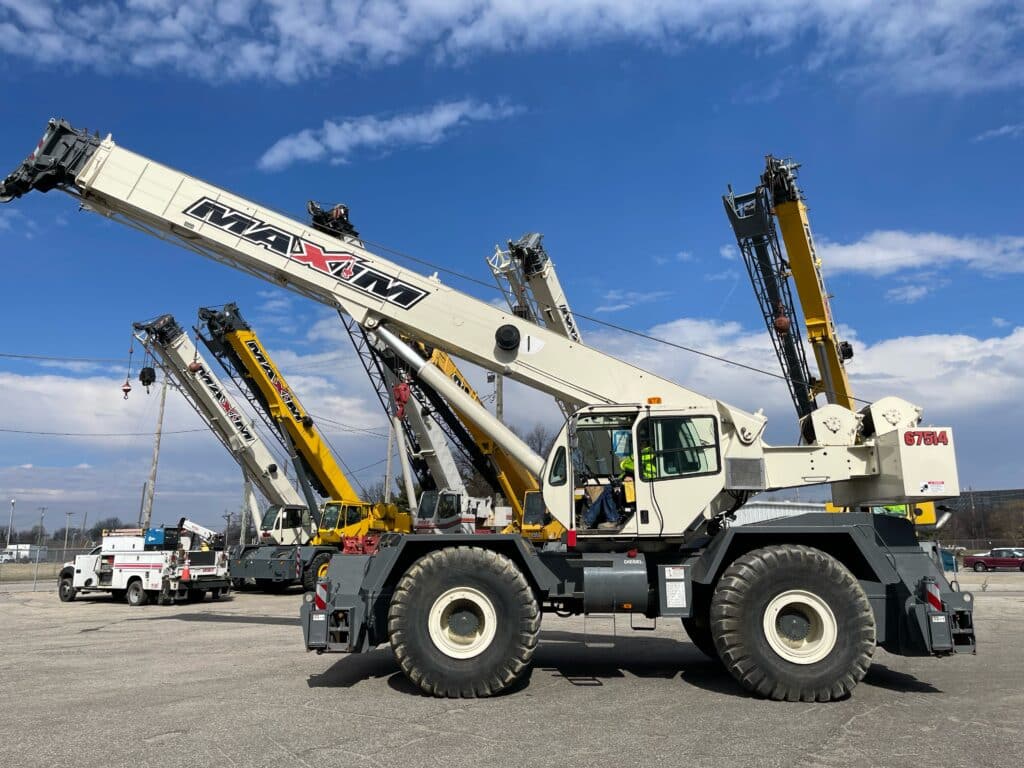
Rough terrain cranes boast a robust design tailored to navigate and perform in less-than-ideal conditions.
Maneuverability Through Multiple Steering Modes
Their defining characteristics include multiple steering modes, which grant the operator the flexibility to maneuver through tight spaces and around obstacles with precision. The steering options typically encompass two-wheel, four-wheel, and crab steering, each serving a specific purpose to enhance the crane’s adaptability on varied job sites.
Enhanced Stability with Independent Outriggers
The stability of rough terrain cranes is another significant aspect of their design. They are equipped with independent H-pattern outriggers that can extend to provide a stable lifting platform even on uneven ground, which aids in efficiency during lift operations.
Versatile Lifting Capacity and Counterweight System
When it comes to lifting power, rough terrain cranes offer variable load capacities, most range from 30 to 165 tons. These cranes are engineered to carry their own counterweights, which are integral to maintaining balance and stability during lifts, allowing for a versatile performance in diverse operational scenarios.
Applications of Rough Terrain Cranes
Rough terrain cranes are engineered to excel in specific settings where traditional cranes might struggle. Their design allows them to operate effectively in off-road construction projects, where the ground is uneven, and space may be constricted. These versatile machines are ideal for industrial tasks that require both mobility and robust lifting capabilities.
Projects that benefit from the unique features of rough terrain cranes often include:
- Construction sites with uneven, muddy, or unstable ground conditions.
- Industrial maintenance work where access is limited due to obstacles or rough landscapes.
- Infrastructure development in remote areas where other crane types cannot travel off-road.
- Power and communication line installations in locations with challenging topography.
The compact size of rough terrain cranes, paired with their powerful performance, makes them indispensable for projects demanding a combination of maneuverability and strength. Their ability to navigate through tight spaces and over obstacles makes them a preferred choice for tasks in rugged terrain environments.
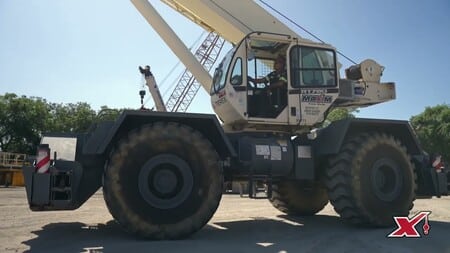
Technological Advancements in Rough Terrain Cranes
The world of rough terrain cranes continues to evolve, driven by ongoing technological advancements. Manufacturers are continually improving crane designs and incorporating the latest innovations in operator assistance systems, ensuring that these machines remain relevant for an array of lifting tasks.
Enhanced Outrigger Designs for Increased Stability
The evolution of outrigger design has resulted in larger spans between contact points, which translates to enhanced stability on uneven ground. Modern models boast improvements in load capacity, allowing them to lift heavier weights more efficiently than their predecessors. This increase in power does not compromise the cranes’ ability to navigate and operate in challenging environments.
Advanced Operator Assistance Technologies
Manufacturers have integrated a variety of operator-assisted features to simplify crane operations and enhance safety. These technological enhancements can include systems for monitoring load weight, wind speed, and boom angle, as well as providing real-time feedback to operators for precise lifting.
Innovations in Outrigger Functionality by Tadano
Tadano, a leading crane manufacturer, has introduced a proprietary asymmetrical outrigger feature, which allows each outrigger to be extended to different lengths, adapting to the space constraints of a work site while ensuring stability during crane operations. This innovation exemplifies the industry’s commitment to advancing rough terrain crane technology to meet the ever-increasing demands of construction and industrial projects.
Benefits of Rough Terrain Cranes
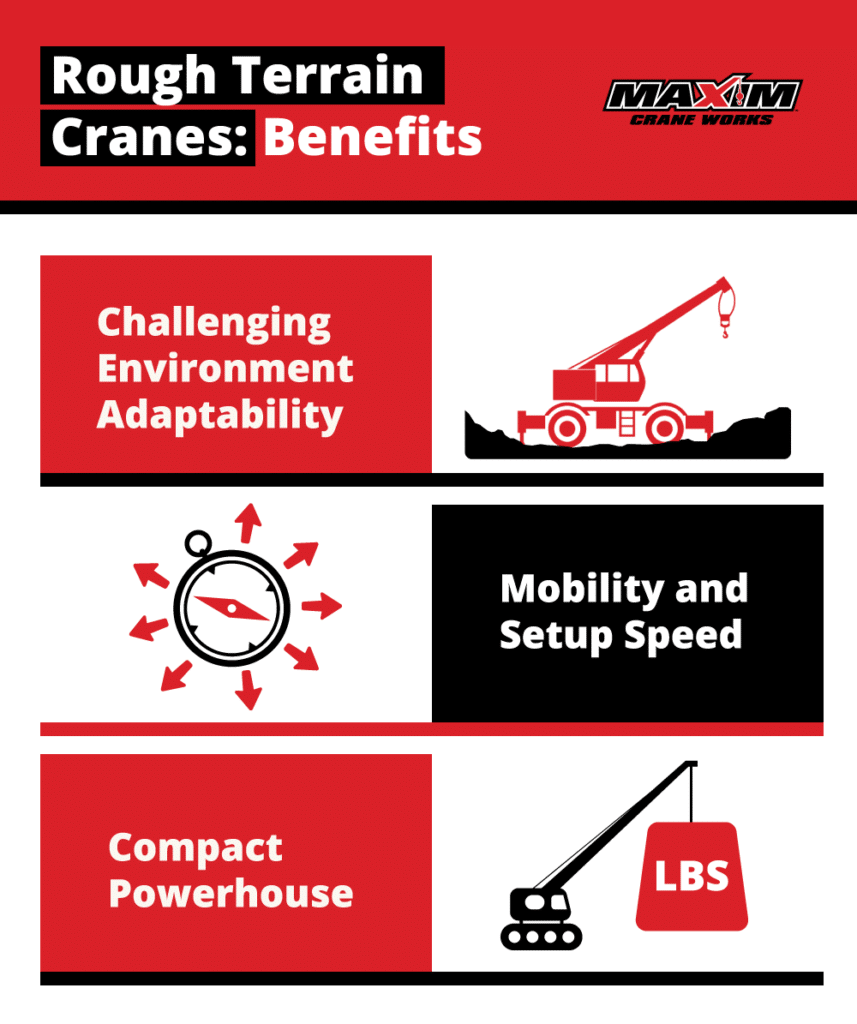
Rough terrain cranes are uniquely designed to offer optimal performance in the harshest and most inaccessible work settings, blending mobility, strength, and technological advancements. Here are some key benefits they provide:
Engineered for Challenging Environments
Rough terrain cranes are engineered to deliver exceptional performance and reliability in some of the most challenging construction and industrial environments. Their design allows for superior maneuverability, enabling them to navigate tight spaces and rugged landscapes where traditional cranes cannot operate effectively. Equipped with larger tires, they provide better control and stability on uneven ground, a critical feature when transporting heavy loads across difficult terrain.
Enhanced Mobility and Setup Efficiency
These cranes boast all-wheel drive and steering, expanding their capability to move in any direction required by the work site’s layout. This feature, combined with its compact size, allows for faster positioning and setup, crucial in projects with time constraints.
Powerful Performance in a Compact Package
Despite their smaller footprint, rough terrain cranes offer more power than other cranes of similar size, ensuring that they can handle substantial loads without compromising on efficiency or safety. This combination of features makes them a versatile and powerful choice for a wide array of lifting tasks.
Maxim Crane Works: Your Partner for Rough Terrain Crane Rentals and Project-Specific Recommendations
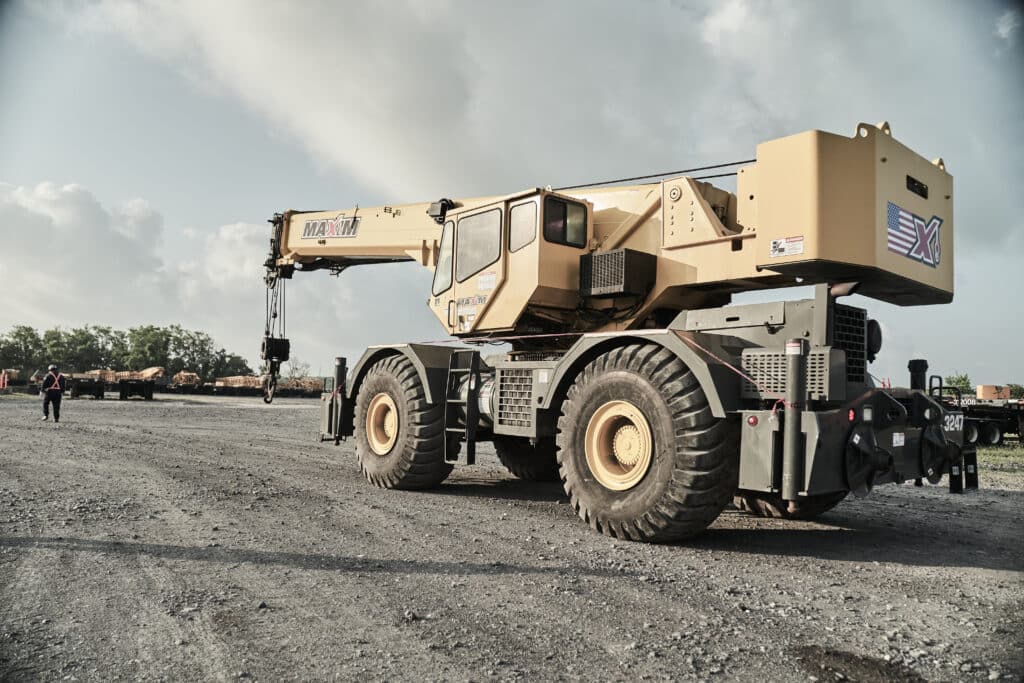
Maxim Crane, one of the largest crane rental companies in North America, offers a diverse fleet of cranes and heavy lift equipment to serve all types of projects. Their rough terrain crane options are engineered for maximum efficiency on off-road job sites, making them ideal for construction, maintenance tasks, and industrial lifting operations in challenging terrain.
Throughout this blog post, we’ve explored the intricacies of rough terrain cranes, highlighting their robust design, impressive capabilities, and ongoing technological advancements. Maxim Crane Works understands the complexities of utilizing rough terrain cranes in diverse project settings and is dedicated to providing customized solutions that align with the precise demands of each project.
By leveraging their extensive fleet and industry experience, they can offer recommendations tailored to the specific challenges and objectives of their clients’ projects, with a focus on both efficiency and effectiveness in crane operations.
Maxim Crane Works stands ready to elevate your project’s efficiency to new heights. Their extensive fleet of rough terrain cranes, coupled with seasoned professionals in heavy lifting services, aims to meet your lifting needs with precision and professionalism. Let Maxim Crane guide you through the selection process and together identify the crane rental solutions that will best serve your unique application requirements. Trust them to lift your project’s potential—literally.


